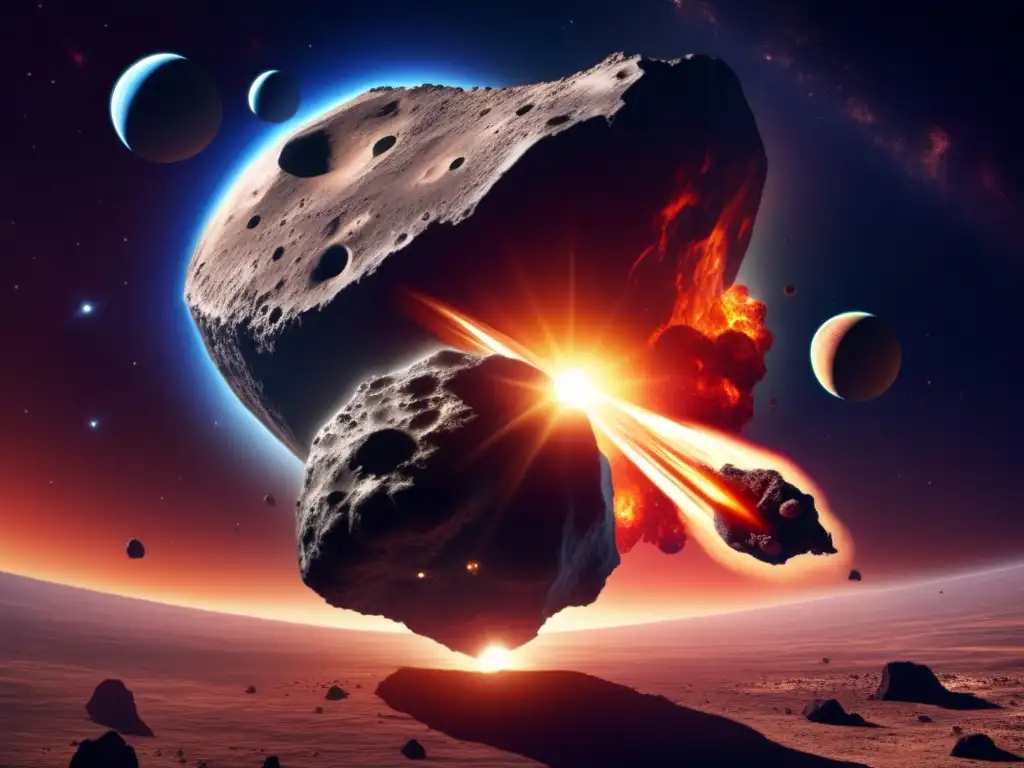Defending The Cosmos: Strategies Against Asteroid Threats

Introduction
Asteroids are celestial objects that are found in the asteroid belt between Jupiter and Mars and occasionally stray into our planet's orbit. When they collide with Earth, they can cause catastrophic events, resulting in loss of life and damage to infrastructure. To mitigate the risks associated with asteroids, it's necessary to develop strategies for planetary defense. This article explores different approaches to defending our planet from asteroid threats.
Tracking Asteroids

Early Detection Techniques
The first step in preventing an asteroid collision is early detection. Scientists use various methods to identify incoming asteroids. One common technique is ground-based telescopes that scan the sky for faint moving objects. NASA also launched a space-based telescope called the Near-Earth Object Surveillance Mission (NEOSM) that aims to detect, track, and catalog nearby asteroids more accurately.
Monitoring Orbital Paths
Knowing an asteroid's size, shape, and composition is crucial in understanding its trajectory and the potential risks it poses. Scientists use radar measurements, optical observations, and spacecraft flybys to determine an asteroid's physical properties. They also monitor the object's orbital path to determine if it will come close to Earth and pose a threat.
Collaboration and Data Sharing
International cooperation among scientists is vital to overcoming the challenges of detecting and tracking asteroids. One such initiative is the International Asteroid Warning Network, which brings together experts from around the world to share data and knowledge on asteroid threats. The network works closely with the United Nations Office for Outer Space Affairs to promote planetary defense efforts globally.
Deflection Techniques

Kinetic Impactors
One method of deflecting an asteroid is to use a kinetic impactor. A spacecraft would slam into the asteroid at high speed, changing its direction and trajectory. NASA's Double Asteroid Redirection Test (DART) mission will test this technique in 2021 by slamming a spacecraft into an asteroid moonlet to change its orbit.
Gravity Tractors
A gravity tractor is a spacecraft designed to use its gravitational pull to alter the course of an asteroid. The spacecraft would hover near the asteroid and use its gravity to pull the object off its collision course with Earth. This technique is still theoretical, but NASA has proposed the Asteroid Redirect Mission as a way to test this technology.
Nukes and Lasers
The use of nuclear weapons or powerful lasers to fragment or vaporize the asteroid is another possible deflection technique. However, this approach requires careful consideration due to the potential for creating many smaller, harder-to-detect asteroids that could still pose a threat to Earth.
Preparing for Impact

Evacuation Plans
In the event of an asteroid impact, early warning systems can help save lives by providing people with time to evacuate. Governments and emergency services need to have evacuation plans and procedures to minimize the damage caused by such an event.
Impact Simulation
Scientists simulate asteroid impacts to better understand the potential effects of a collision. These simulations help local authorities prepare for the most likely scenarios and develop appropriate response strategies.
Emergency Response Teams
Emergency response teams play a vital role in mitigating the impacts of an asteroid collision. These teams need to have specialized training and equipment to handle the aftermath of such an event. NASA's Planetary Defense Coordination Office leads international efforts to plan and respond to the aftermath of a potential asteroid impact.
Frequently Asked Questions

-
What is the chance of an asteroid hitting Earth?
The probability of a destructive asteroid impact varies depending on the size and frequency of asteroid collisions. The likelihood of a large asteroid hitting Earth is relatively low, but the consequences would be catastrophic.
-
How far in advance can we detect incoming asteroids?
Depending on the size and speed of an asteroid, it could take anywhere from a few days to several years to detect and track it.
-
Can we destroy an incoming asteroid?
There are various deflection techniques that can be used to alter the trajectory of an asteroid. However, destroying an asteroid would require a massive amount of energy and may not be feasible or advisable.
-
What should I do if an asteroid is headed towards my city?
Follow your local government's instructions and evacuation plans. In most cases, it's safer to evacuate to designated safe zones than to stay near the impact site.
-
Are there any ongoing missions to test asteroid deflection technologies?
Yes, NASA's DART mission will test the kinetic impactor technique in 2021, and the Asteroid Redirect Mission aims to test the gravity tractor technique.
Conclusion
Defending the cosmos against asteroid threats is a complex and ongoing challenge that requires global cooperation and innovation. By tracking, deflecting, and preparing for potential impacts, we can reduce the risk of catastrophic events and safeguard our planet's future.
We urge readers to stay informed about planetary defense efforts and participate in initiatives that promote awareness of the threats posed by asteroids. Let's work together to ensure the safety and sustainability of our planet for future generations.
Additional Resources

For further reading on the topic, we recommend:
 Beyond The Asteroid: The Science Of Planetary Defense
Beyond The Asteroid: The Science Of Planetary Defense Staying Alive: Techniques For Planetary Defense
Staying Alive: Techniques For Planetary Defense Interstellar Defenders: Tools For Asteroid Defense
Interstellar Defenders: Tools For Asteroid DefenseIf you want to discover more articles similar to Defending The Cosmos: Strategies Against Asteroid Threats, you can visit the Planetary Defense category.
Leave a Reply

Articulos relacionados: